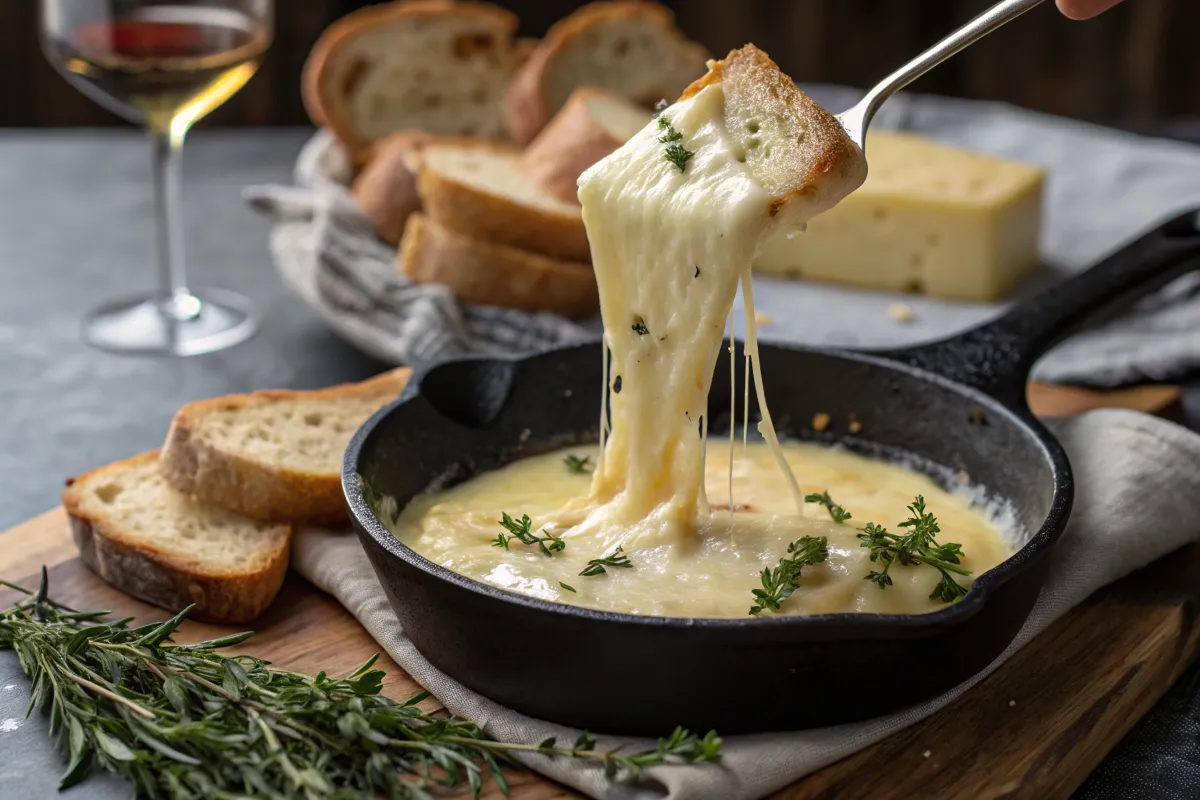Introduction to Gruyere Cheese
If you’re a cheese lover, you’ve probably come across the creamy and nutty delight that is Gruyere cheese. Whether it’s used in a classic fondue, baked into a cheesy flatbread, or grated over a rich casserole, Gruyere cheese is celebrated for its smooth melting properties and full-bodied flavor. But what makes this cheese so special, and why is it now one of the most popular choices in kitchens around the world?
From its origins in Switzerland to its versatility in recipes like smoked mac and cheese and grilled cheese sandwiches, Gruyere cheese has earned its place as a kitchen essential. It’s perfect for everything from gourmet meals to simple comfort food. Additionally, if you’re looking for alternatives, cheeses like manchego, provolone, and romano cheese can work as excellent substitutes.
In this guide, you’ll discover all there is to know about Gruyere cheese, including its unique characteristics, substitutes, and how to incorporate it into a variety of recipes. Let’s dive into the delicious world of this culinary gem!
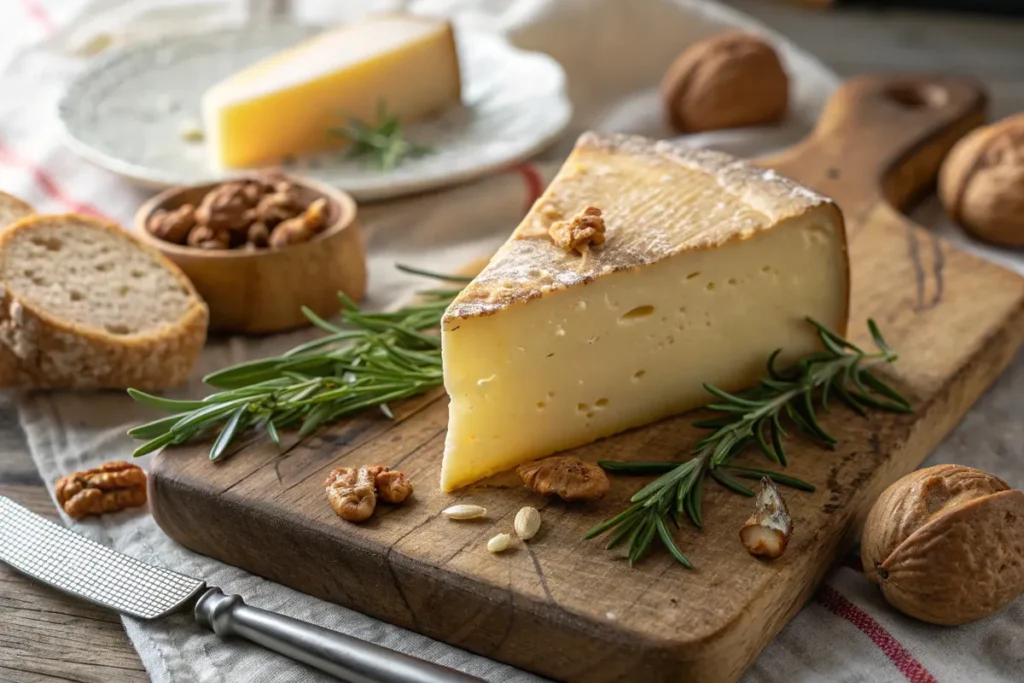
Table of contents
Why This Cheese is So Popular
What Makes It Unique?
One of the standout qualities of this cheese is its smooth, creamy texture and nutty flavor. Unlike cheddar cheese, which is sharper, it has a subtle sweetness that works well in many recipes. This cheese also melts beautifully, making it perfect for dishes like smoked mac and cheese or fondue.
Its versatility means it can be shredded, sliced, or melted. For example, you can use it in a bubbling French onion soup or layered into a decadent casserole. Whether you’re adding it to a cottage cheese flatbread or crafting a gourmet grilled cheese sandwich, this cheese always enhances the dish.
How It Compares to Other Cheeses
This cheese stands out when compared to other popular varieties. Here’s how it stacks up:
- Cheddar Cheese: While cheddar adds a sharp and tangy taste, it lacks the creamy and nutty flavor of this Swiss-style cheese.
- Manchego Cheese: Manchego has a firm texture with a nutty sweetness, similar to this cheese, but it doesn’t melt as smoothly.
- Provolone Cheese: Provolone is mild and creamy, making it a great substitute in dishes like sandwiches or baked pasta.
- Romano Cheese: Romano is saltier and bolder, better suited for toppings rather than as a melting cheese.
Each cheese has its strengths, but this Swiss variety’s combination of flavor and texture makes it perfect for both casual meals and gourmet dishes. Whether shredded or used as part of a cheese wheel, it never disappoints.
Top Culinary Uses
This cheese is incredibly versatile, which is why it’s a favorite in kitchens around the world. Here’s how you can use it:
- Casseroles and Gratins: Its melting quality creates a creamy base and golden crust, perfect for dishes like gratins or vegetable bakes.
- Soups and Stews: Add a handful of shredded cheese to soups like French onion or creamy potato to create a rich, luxurious finish.
- Baked Dishes: Use it in quiches, savory pies, or even stuffed pasta for a smooth, indulgent layer of flavor.
To prepare it perfectly, tools like a cheese slicer can help you create thin, even layers for sandwiches or charcuterie boards. If you’re making grilled cheese sandwiches, a grilled cheese maker ensures that the cheese melts evenly and pairs beautifully with crusty bread.
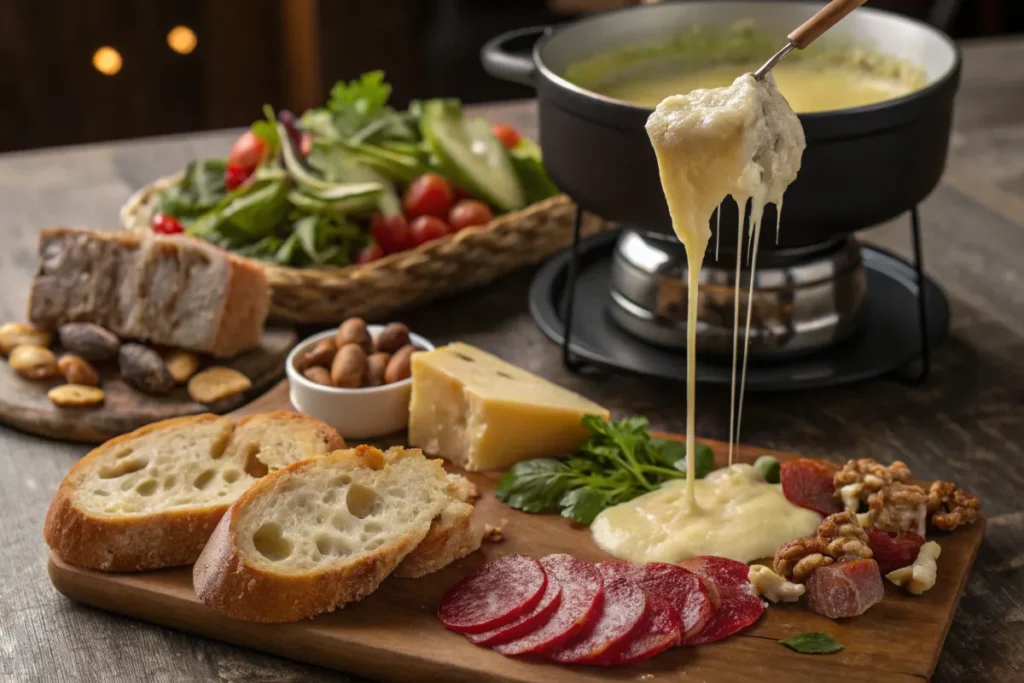
Exploring Gruyere Cheese Substitutes
While Gruyere cheese is a favorite for its creamy and nutty flavor, there are times when you might need a substitute. Fortunately, there are several excellent alternatives that can mimic Gruyere’s texture and flavor in different recipes. From rich and creamy options like provolone cheese to sharper choices like romano cheese, you’ll find a variety of cheeses that fit your needs. Below, we’ll explore some of the best substitutes and how to use them.
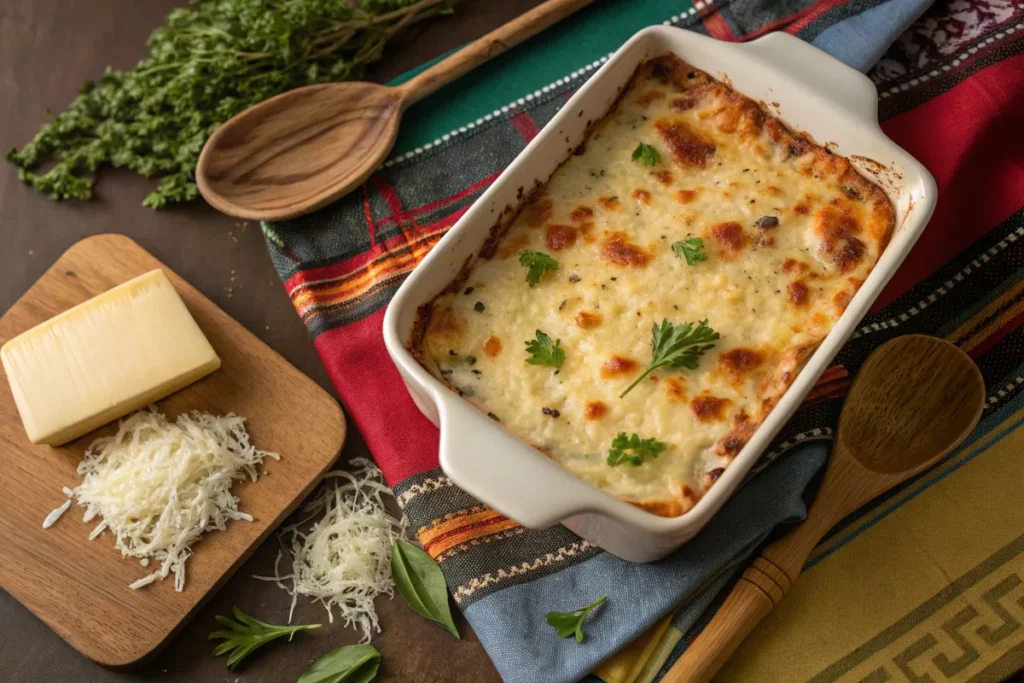
Romano Cheese and Cheddar Cheese: Bolder Flavors
For dishes that need a stronger flavor, romano cheese and cheddar cheese are excellent choices. Romano is saltier and more robust than Gruyere, so it’s best used as a topping for pasta or salads. You can also combine romano with a milder cheese, like provolone, for a balanced taste.
Meanwhile, cheddar cheese is sharper and tangier, offering a bold twist to recipes. It works well in baked dishes, soups, and savory pastries. For example, when added to a cottage cheese flatbread, cheddar creates a rich, cheesy flavor that stands out.
Creamy Substitutes for Spreads and Fillings
If you’re looking for a softer option, cream cheese filling or cottage cheese can replace Gruyere in recipes that don’t require melting. These creamy substitutes are perfect for dips, spreads, or stuffed pasta dishes like ravioli or cannelloni.
Additionally, shredded rope cheese or soft cheeses like goose cheese can provide a unique twist. While they may not replicate Gruyere’s nutty flavor, their textures work well in cold dishes or appetizers. For lighter recipes, these options can also help reduce the overall calorie count, especially if you’re watching cream cheese
Tips for Choosing the Right Substitute
- Match the Flavor Profile:
When selecting a substitute, consider the dish you’re making. For nutty and earthy flavors, manchego cheese is the closest match. If you want a creamy, mild taste, go for provolone cheese or cream cheese filling. - Consider Melting Properties:
For dishes that require melting, like gratins or casseroles, choose a cheese that melts smoothly, such as provolone or cheddar cheese. Firmer cheeses like romano cheese are better suited for grating over finished dishes. - Experiment with Combinations:
You don’t always need one cheese to replace Gruyere. Mixing cheeses, like romano and provolone, can mimic both the flavor and texture of Gruyere. Use tools like a cheese slicer to prepare them precisely for your recipe.
Cooking with Cheese: Elevating Every Dish
Cheese has the power to turn a simple recipe into something truly indulgent. Whether it’s the creamy melt of Gruyere cheese, the tang of cheddar cheese, or the mild richness of provolone cheese, the right cheese can transform your cooking. Let’s explore how you can use different cheeses, like manchego cheese or even a gruyere cheese substitute, to elevate everyday meals, comfort foods, and gourmet dishes.
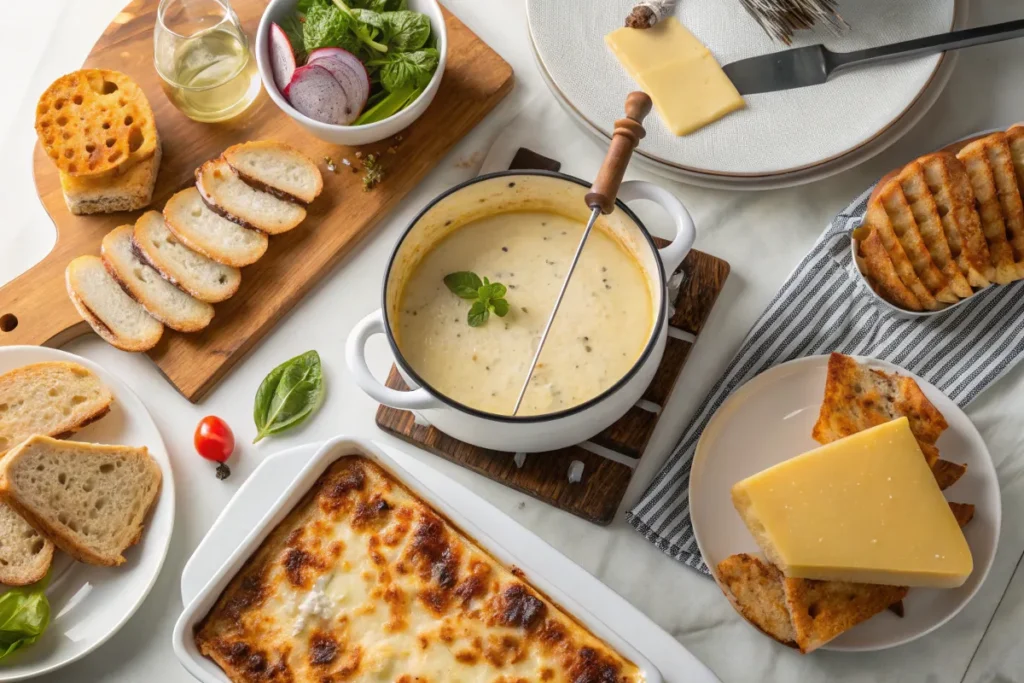
Comfort Foods with a Cheesy Twist
Some of the most satisfying dishes are packed with cheese, and for good reason—it brings warmth, richness, and comfort. Here’s how you can make cheese the star of your favorite recipes:
- Smoked Mac and Cheese: Use a blend of Gruyere cheese, cheddar cheese, and romano cheese for a creamy, smoky mac and cheese that’s perfect for dinner or a potluck. The Gruyere adds a nutty creaminess, cheddar provides a sharp tang, and romano offers a salty finish.
- Grilled Cheese Sandwiches: Whether you’re using a grilled cheese maker or a stovetop pan, adding a layer of provolone cheese alongside shredded manchego cheese creates a gooey, flavorful combination.
- Cottage Cheese Flatbread: Swap plain toppings for a mix of cream cheese filling and shredded rope cheese. This adds a creamy, stretchy texture to every bite.
Comfort food is all about indulgence, and cheese has the versatility to fit into both casual and refined recipes.

Gourmet Creations with Cheese
Cheese isn’t just for casual meals—it’s also the hero of gourmet dishes. You can use high-quality cheese to elevate your next dinner party or date-night recipe.
- Savory Tarts and Pies: A quiche or savory tart filled with Gruyere cheese pairs beautifully with roasted vegetables like asparagus or spinach. For added flair, try sprinkling shredded manchego cheese or romano cheese on top for extra flavor.
- Cheese Platters: No dinner party is complete without a cheese wheel or platter. Pair slices of head cheese, goose cheese, and provolone cheese with fruits, nuts, and crackers for a balanced board. A tool like a cheese slicer can create thin, uniform slices for a polished presentation.
- Savory Soups: Adding Gruyere or cheddar cheese to soups like French onion or creamy potato enhances their texture and flavor. Top it off with crispy croutons for a complete dish.
Cheese Tips for Every Cook
- Layer Flavors with Combinations:
Mixing different cheeses can enhance your dishes. For example, combine shredded manchego cheese with creamy provolone cheese for baked pasta dishes. Or add a touch of sharp romano cheese to top salads or flatbreads. - Tools to Elevate Presentation:
For precision and elegance, use a cheese slicer to create thin, even slices for platters or sandwiches. Similarly, a grilled cheese maker ensures perfectly melted cheese with crispy bread every time. - Explore Substitutes for Variety:
If you’re out of Gruyere, try manchego cheese, provolone cheese, or even cheddar cheese to achieve similar results. Substituting cheese can add new dimensions to your recipes, making them exciting and unique.

Cheese in Every Dish: Endless Possibilities
From bold and salty romano cheese to stretchy rope cheese, there’s a perfect cheese for every recipe. With so many options, like gooey smoked mac and cheese or a layered cottage cheese flatbread, you can experiment with textures and flavors to create dishes that impress. Don’t forget to stock up on kitchen tools like a cheese slicer or a grilled cheese maker to make your cheese recipes even easier to prepare.
So whether you’re crafting gourmet delights or indulging in comfort food, cheese is the ingredient that brings joy to every table.
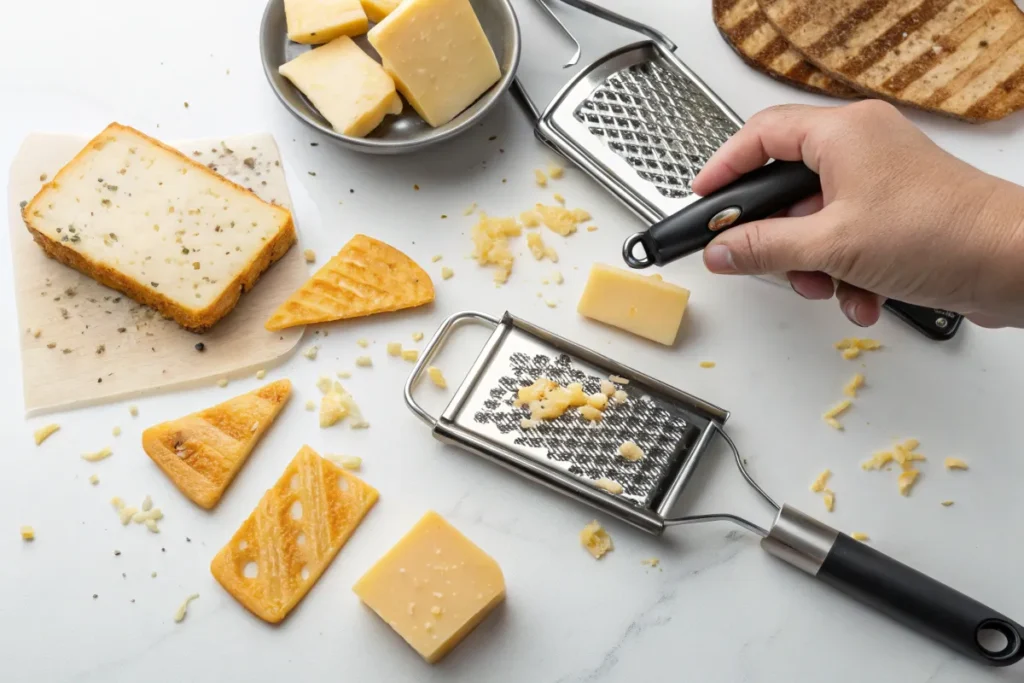
Gruyere Cheese vs. Other Cheeses: How It Stacks Up
When it comes to cheese, each type offers something unique—whether it’s the bold tang of cheddar cheese, the mild creaminess of provolone cheese, or the crumbly saltiness of romano cheese. But how does Gruyere cheese, known for its creamy texture and nutty flavor, compare to these other varieties? Let’s dive into a comprehensive comparison of Gruyere and its counterparts to understand why it’s considered one of the most versatile and popular cheeses.
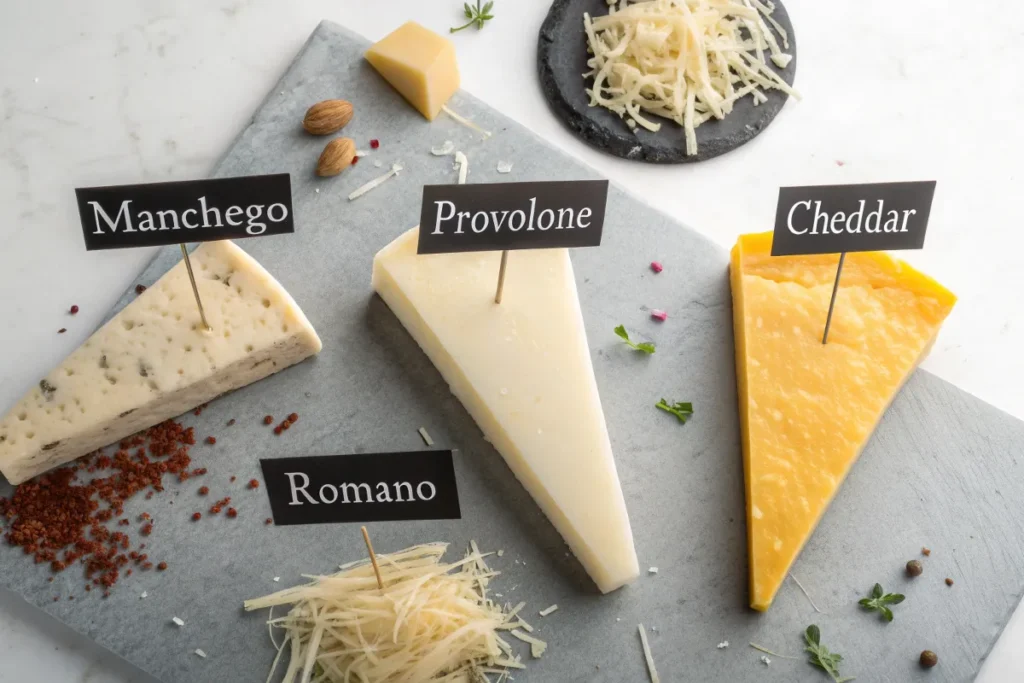
Gruyere Cheese vs. Cheddar Cheese
Cheddar cheese is sharper and tangier than Gruyere, making it a bold choice for dishes like burgers, nachos, or smoked mac and cheese. However, cheddar lacks Gruyere’s earthy sweetness and smooth melting properties, which are ideal for fondues, gratins, or casseroles.
- Best Uses for Gruyere: Fondue, quiches, savory tarts, and creamy soups.
- Best Uses for Cheddar: Mac and cheese, burgers, and baked snacks like cheese and stick appetizers.
Gruyere Cheese vs. Manchego Cheese
Manchego cheese has a firmer texture and a nutty, slightly sweet flavor similar to Gruyere, but it doesn’t melt as smoothly. Manchego is ideal for charcuterie boards, cheese wheel platters, or as a topping for flatbreads. Gruyere, on the other hand, is better for baked dishes or recipes that need a creamy consistency.
- Best Uses for Gruyere: Melting into casseroles, gratins, and creamy sauces.
- Best Uses for Manchego: Sliced for cheese platters, rope cheese snacks, or grated over salads.
Gruyere Cheese vs. Provolone Cheese
Provolone cheese is mild, creamy, and highly versatile. It melts well, making it a great substitute for Gruyere in dishes like sandwiches or baked pasta. However, provolone lacks the distinct nutty flavor of Gruyere, which adds depth to dishes like French onion soup or savory pies.
- Best Uses for Gruyere: Fondue, French onion soup, and gourmet baked dishes.
- Best Uses for Provolone: Grilled cheese sandwiches, pizzas, and Italian-style baked dishes.
Gruyere Cheese vs. Romano Cheese
Romano cheese is much saltier and sharper than Gruyere, making it better suited for grating over pasta or salads. While Romano doesn’t have the creamy melting qualities of Gruyere, its bold flavor adds a punch to dishes that need a salty kick.
- Best Uses for Gruyere: Smooth, creamy recipes like quiches, soups, and gratins.
- Best Uses for Romano: Grated over pasta, pizza, or vegetable dishes.
Gruyere Cheese Substitutes
If you’re out of Gruyere, there are plenty of substitutes that work well in its place:
- Manchego cheese or provolone cheese for a nutty or creamy alternative.
- Romano cheese for a sharper, saltier flavor.
- Shredded cheese blends that combine mild and sharp flavors for balance.
When substituting Gruyere, always consider the dish. For creamy recipes like smoked mac and cheese, opt for cheeses with good melting properties like provolone. For grated toppings, go with romano or manchego.
Specialty Cheeses Compared to Gruyere
- Cheese Wheel and Head Cheese
While Gruyere is often sliced or shredded, cheeses like cheese wheel varieties and head cheese are best served on charcuterie boards or as snacks. Gruyere offers more versatility, as it can be melted, shredded, or baked into dishes. - Cottage Cheese Flatbread
Gruyere adds a gourmet touch to flatbreads, while cottage cheese serves as a lighter alternative for toppings. Cottage cheese works well for calorie-conscious meals, while Gruyere brings a richer, creamier flavor. - Rope Cheese and Cheese and Stick Snacks
Rope cheese and cheese and stick snacks are portable and fun, but they lack the complexity of Gruyere’s flavor. These are great for casual snacking, while Gruyere is more suited for elevating recipes.
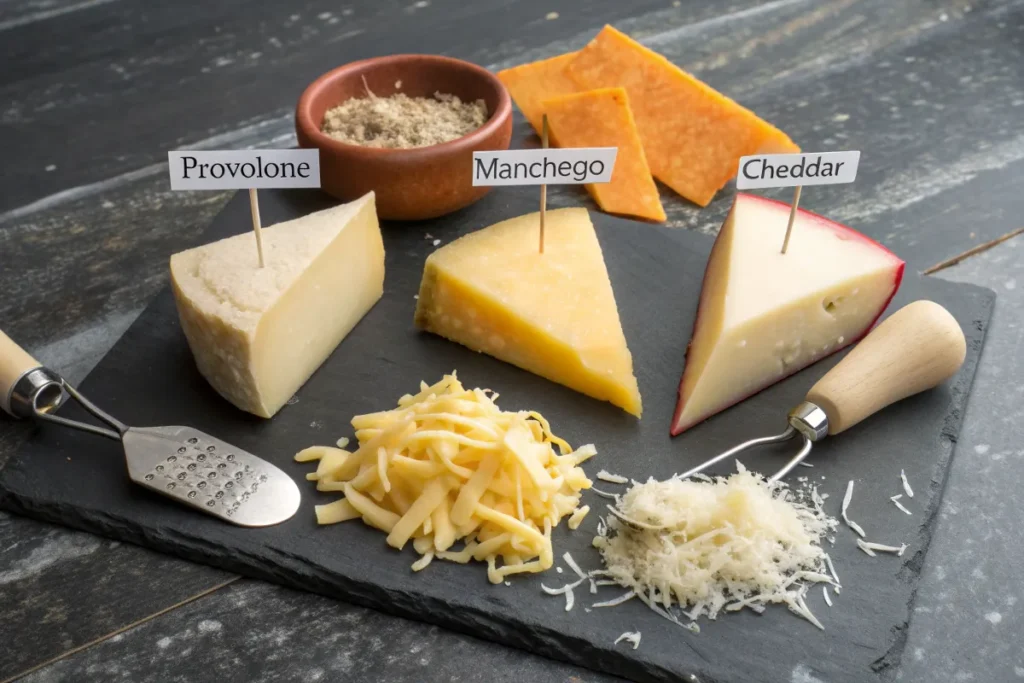
Cheese Tools and Their Role
- Grilled Cheese Maker:
A grilled cheese maker brings out the best in both Gruyere and provolone, creating perfectly melted sandwiches with crispy bread. - Cheese Slicer:
Use a cheese slicer to create thin, even slices of Gruyere or manchego cheese for sandwiches, platters, or recipes like cottage cheese flatbread.
Final Thoughts
Gruyere cheese stands out for its rich flavor and versatility, but other cheeses like cheddar cheese, manchego cheese, and provolone cheese each bring their own strengths to the table. Whether you’re melting Gruyere into a fondue, grating romano over pasta, or crafting a flatbread with cottage cheese, each type of cheese has its unique place in your kitchen.
Don’t forget to use tools like a grilled cheese maker for gooey sandwiches or a cheese slicer for elegant presentations. From cheese wheels to smoked mac and cheese, the possibilities with cheese are endless. Explore, experiment, and enjoy!
Frequently Asked Questions About Gruyere Cheese

Gruyere cheese is creamier and melts better, making it ideal for baked dishes and soups. On the other hand, manchego cheese has a firmer texture and is often sliced for cheese platters or grated over dishes.
While Gruyere cheese has a nutty and mildly sweet flavor, cheddar cheese is sharper and tangier. Gruyere melts smoothly and is ideal for creamy recipes, while cheddar works best in dishes requiring bold flavors, like burgers or mac and cheese.
Absolutely. A cheese slicer is great for creating thin, uniform slices of Gruyere for cheese boards or sandwiches. Meanwhile, a grilled cheese maker ensures that Gruyere melts evenly and the bread turns golden and crispy.
Yes, Gruyere cheese is rich in protein and calcium, which are essential nutrients. However, it is also high in fat, so moderation is key. If you’re watching your intake, you can balance it with lighter cheeses like cottage cheese or monitor cream cheese for alternative options.
Yes! Gruyere cheese is an excellent addition to smoked mac and cheese because it melts smoothly and adds a nutty richness. Combine it with other cheeses like cheddar or romano for a layered flavor profile.
Yes! Gruyere cheese is perfect for cottage cheese flatbread or savory tarts. Its creamy texture and nutty flavor enhance the overall taste. Pair it with vegetables or herbs for a gourmet touch.

